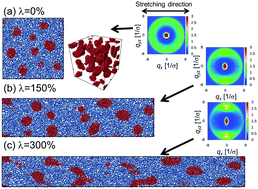Scattering patterns and stress–strain relations on phase-separated ABA block copolymers under uniaxial elongating simulations
Abstract
To develop molecularly based interpretations of the two-dimensional scattering patterns (2DSPs) of phase-separated block copolymers (BCPs), we performed coarse-grained molecular dynamics simulations of ABA tri-BCPs under uniaxial stretching for block-fractions where the A-segment (glassy domain) is smaller than the B-segment (rubbery domain), and estimated the behaviour of their 2DSPs. In BCP stretching experiments, mechanical properties are generally evaluated using a stress–strain curve. We obtained 2DSPs with different contrasts for the A- and B-segments, which are indicative of the differences between X-ray and neutron scattering experiments. The small- and wide-angle behaviours of the 2DSPs originate from the morphologies of the phase-separated domains and local bond orientations, respectively. When the block-fractions are changed for a constant stress value on the stress–strain (SS) curve, the brightness of the spots in the wide-angle region of the A- and B-segment-dominant 2DSPs decreases and increases with increasing strain, respectively. We can regard the systematic changes in the small-angle 2DSPs of the glassy domain and the wide-angle 2DSPs of the rubbery domain with changes in the SS-curve as a structure–property relationship.



 Please wait while we load your content...
Please wait while we load your content...